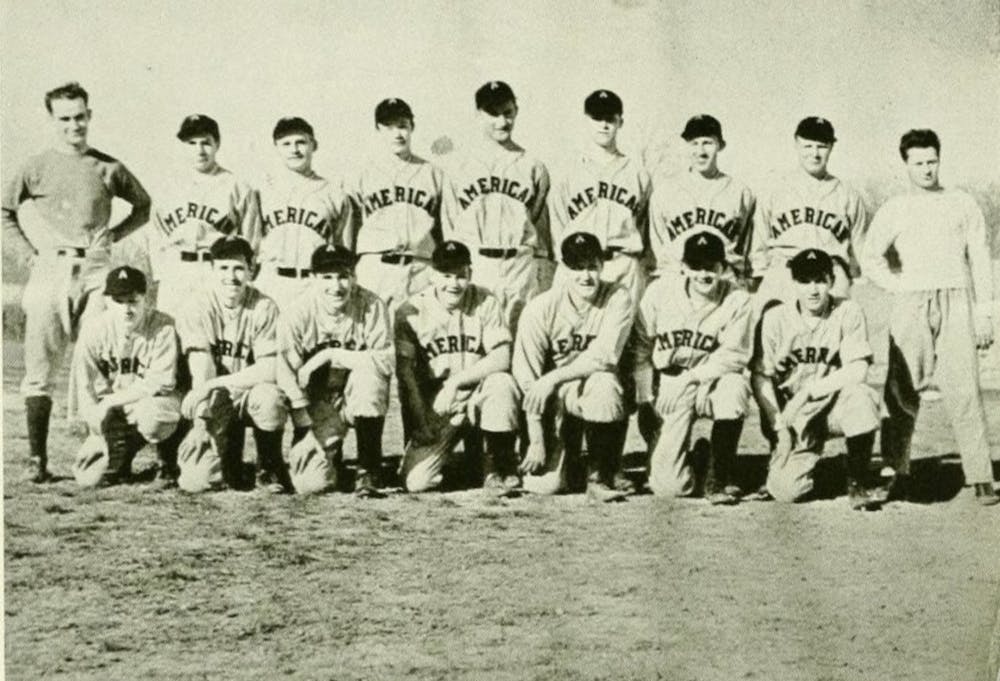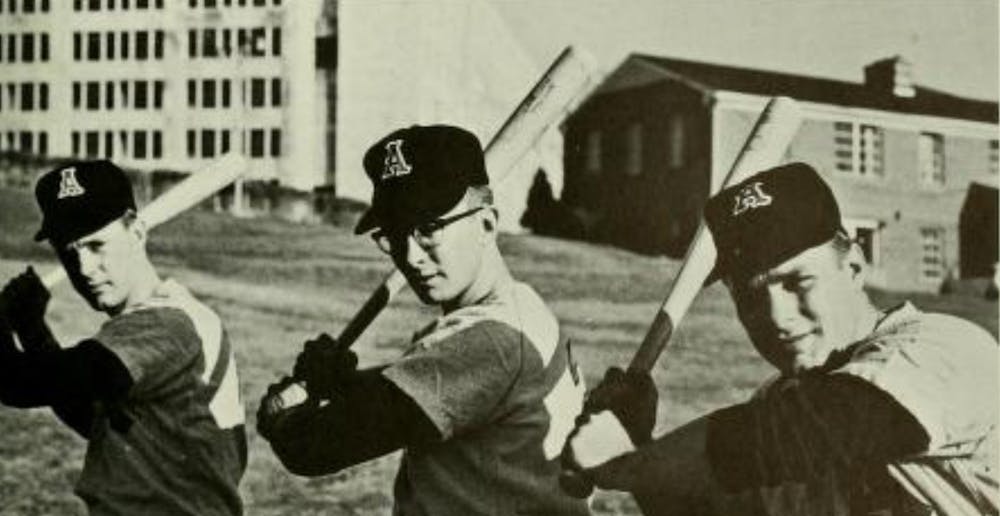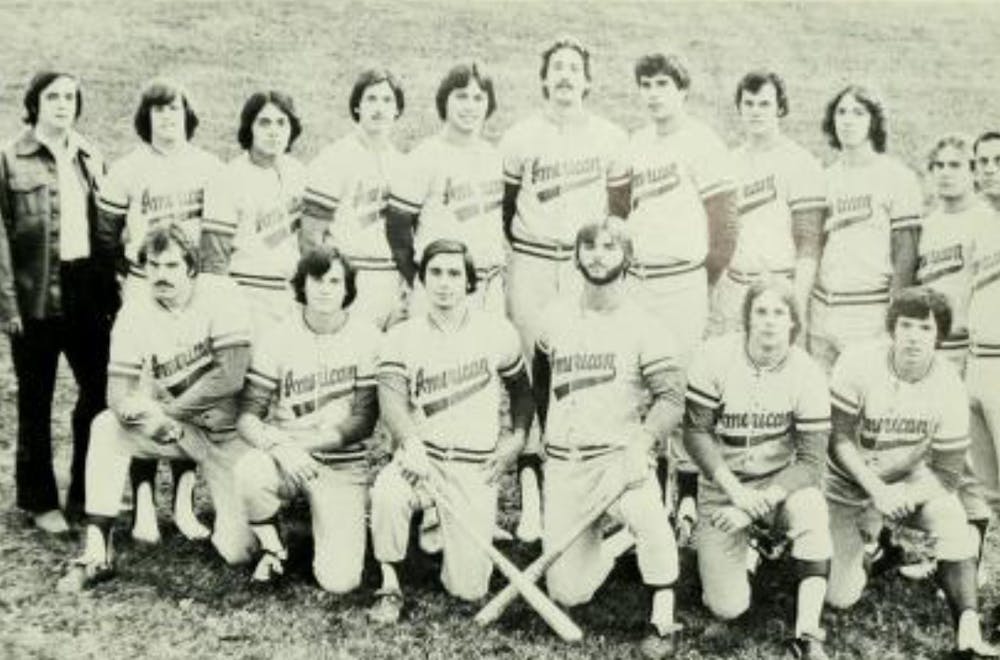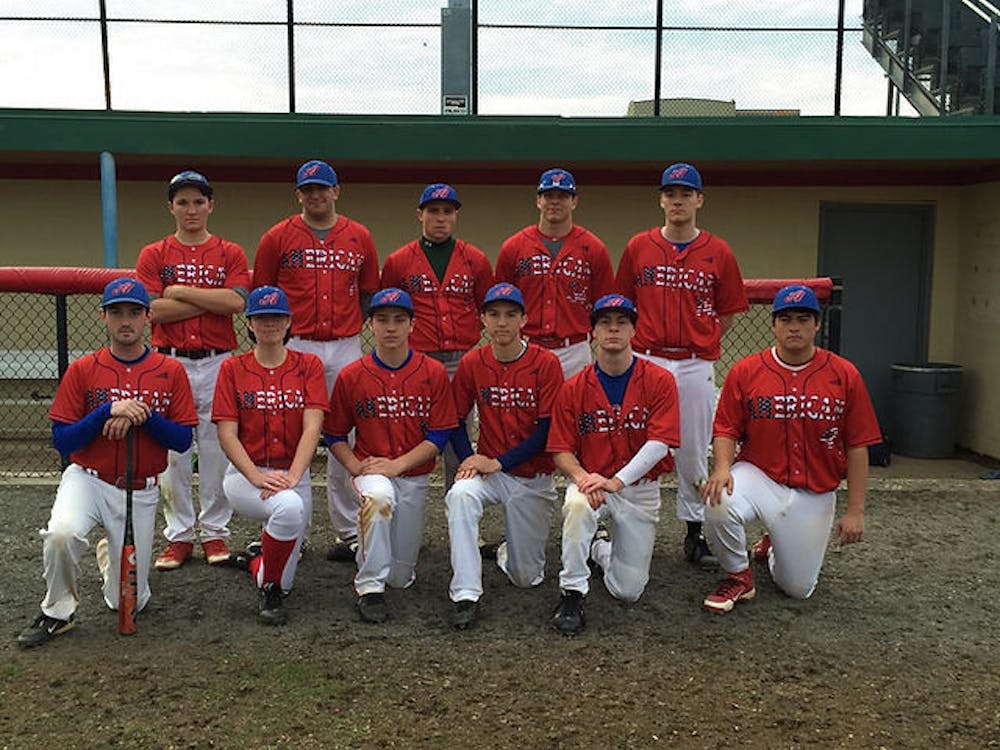“I haven’t played third base since I was twelve,” said club baseball senior Trevor Anderson before trotting out to the hot corner to take infield before game two of a doubleheader in Southwest D.C. on April 6. Anderson caught the first game and is now playing third as a necessity, due to the just nine players who showed up on the sunny April afternoon.
The American University club baseball team has struggled with numbers all year, their secretary is their coach, their catcher is their third baseman and their bench is…. empty.
Things did not used to be this way. Walking through campus you can see relics of the team that once was. Jacobs Field sports a seldom-used turf baseball diamond and painted on the wall of an equipment shed, there is an old scoreboard. Next to the field sits a plaque, memorializing the teams of the past, and making clear the fact that the diamond is not for baseball, it is but a historical memento. The wall of fame in Bender is full of baseball players, thirteen of them forever enshrined in our school’s athletic history. So why now is our baseball team struggling to find nine guys to show up to one of their four regular season games?
Baseball at AU can be traced back to just under a century ago, in 1928, when the American University “Nine” played their first game against their cross-town rivals, the George Washington Engineers. They lost that game, and then lost their second game the next day against St. John’s, before beating GW in their first-ever win. They rode the high of that win for the next few weeks, until the fateful day in May when they rolled up to play the University of Virginia, their first game against a Division I school. That day marked the first and last time that the American University baseball team made the front page of the sports section of a major newspaper. In what was possibly the biggest blowout in collegiate baseball history to that point, they lost 42-0.
The Nine returned the next year in 1929 before making the first of their many disappearances. It was not until ten years later, in 1939, that they resurfaced, under the guidance of none other than American University legend, Stafford “Pop” Cassell. The team was brought back in no small part due to the persistence of George Brown, who led the committee to bring the team back, and later became an AU Hall of Famer. Cassell resigned a few years later, and the history of the team got murky for a few years, as the attention of the country soon turned to the war, with Americans having less time for frivolous activities like baseball. However, in 1947, the boys came home, and baseball returned to American University.

This is the start of the longest consecutive streak of baseball at AU. This streak lasted from 1947 until the early 90s and saw conference champions, Major League Baseball draft picks, and a brand new baseball field. It also saw years of mediocrity and everything that had taken years to build, fall away.
In 1966, the Nine peaked, winning the Mason-Dixon conference, and their star center fielder Bill Mason was named an All-American. Mason set AU’s single-season and career records for batting average, home runs, runs batted in, and slugging percentage. Following his graduation, he was drafted by the New York Yankees. To this day, Bill Mason just might be the best baseball player our school has ever seen. 1966 was also the second year of head coach Dee Frady’s tenure with the University. Twenty years later, Frady would win his 400th game, becoming American’s most celebrated baseball coach.

Things continued positively for the team, who at this point were going by the “Eagles.” In 1979, AU boasted a 16-2 record, and they won the Capital Collegiate Conference tournament against other DMV schools.

However, just seven years after their conference tournament championship, the team disappeared, and no one really knows why. The Washington Post claimed that it was due to “alleged procedural violations involving financial aid for baseball players,” though the University denied that that was their rationale. Meanwhile, AU student journalist and Editor-in-Chief of The Eagle David Aldridge reported that Athletic Director Bob Frailey blamed the termination of the team on AU’s schedule, which ended classes at the end of April in the middle of the baseball season.
No matter the reason, this marked the end of an era for baseball at American University. A club team was formed with the varsity players who chose to stick around. The team played games for several years, before fading away unceremoniously sometime in the late 90s. In 2005, AU unveiled its latest sports facility: Jacobs Field. The destruction of AU’s baseball diamond was, for many, the nail in the coffin of baseball at the school.
However, much like cicadas, baseball at AU seems to keep on reemerging. It came back once again in 2010 when a group of freshmen decided to restart the defunct club. This iteration attempted to establish some legitimacy, as the group joined the National Club Baseball Association, a governing body that helps plan games. However, it too disappeared sometime between 2018 and the coronavirus pandemic.
For one more time, baseball again returned in 2022. Only one scrimmage was played, but the following two years have seen four-game seasons played in the fall and the spring.
While baseball at AU still exists, it would be hyperbolic and inaccurate to claim that it is back and better than ever. The team plays many of its old foes, including George Washington, but yet something feels missing.
The main issues that the current team faces are people and resources. Baseball is a sport with a relatively high barrier to entry with the need for a lot of equipment. The team also struggles to find quality fields to practice on, and cannot afford to pay a coach, which further hinders their ability to excel.
Now, let’s return to that sunny Saturday from a few weeks ago. The team on the other end of the doubleheader was Howard.
Howard, too, used to have a varsity baseball team, which folded in 2002. Their club team, founded in 2009, is currently attempting to convince their administration to grant them DI status, and they are presenting a pretty convincing argument. Their team has coaches, is involved in their community, draws fans and appears on the exterior like they are already varsity. Howard is trailblazing a path American needs to follow if we hope to restore baseball to what it once was.
Correction: A previous version of this article incorrectly identified the team’s coach as the treasurer. The article has been updated to identify him as the secretary.
This article was edited by Penelope Jennings, Delaney Hoke and Abigail Turner. Copy editing done by Luna Jinks and Ariana Kavoossi.





